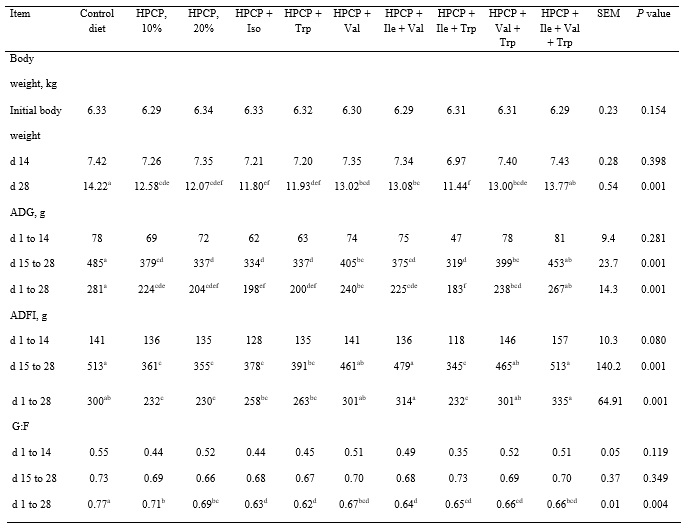High protein corn protein (HPCP) is a corn co-product derived from the ethanol industry that contains between 40 and 50% crude protein, and therefore, may be used in diets for pigs as a source of amino acids (AA). However, such diets will contain more than twice as much Leu as recommended and there is a negative relationship between dietary Leu and brain synthesis of serotonin, which results in reduced feed intake of pigs fed diets containing excess Leu. There is also a reduced protein synthesis because of increased Val and Ile metabolism due to excess dietary Leu. As a consequence, pigs often have reduced growth performance if fed diets with high concentrations of HPCP. However, it may be possible to counteract the negative effects of the high Leu concentrations in corn co-products by adding crystalline sources of Trp, Val, and Ile to the diets and it may, therefore, be possible that HPCP can be used in diets without influencing growth performance or intestinal health of weanling pigs. Therefore, the hypothesis that HPCP may be used as the primary source of AA in diets for weanling pigs if diets are fortified with crystalline AA was tested.
Experimental design
A two-phase feeding program was used with day 1 to 14 as phase 1 and day 15 to 28 as phase 2. A total of 320 weanling pigs with an initial body weight (BW) of 6.11 ± 0.66 kg were used in two blocks of 160 pigs. Within each block, pigs were randomly assigned to ten dietary treatments in a randomized complete block design. There were two barrows and two gilts in each pen and eight replicate pens per treatment. A control diet based on corn and SBM was formulated and two basal diets were formulated based on corn and 10% HPCP or corn and 20% HPCP. Seven additional diets were formulated by supplementing the diet with 20% HPCP with crystalline Ile, Trp, and Val as follows: 1) HPCP + 0.10% Ile; 2) HPCP + 0.05% Trp; 3) HPCP + 0.10% Val; 4) HPCP + 0.10% Ile + 0.10% Val; 5) HPCP + 0.10% Ile + 0.05% Trp; 6) HPCP + 0.10% Val + 0.05% Trp; 7) HPCP + 0.10% Ile + 0.10% Val + 0.05% Trp. All diets in phases 1 and 2 were formulated to meet the current estimates for nutrient requirements by nursery pigs (NRC, 2012). Average daily feed intake (ADFI), average daily gain (ADG), and average gain:feed ratio (G:F) were calculated for each phase and for the overall experiment. Fecal scores were were assessed visually per pen every other day using a score from 1 to 5 (1 = normal feces; 2 = moist feces; 3 = mild diarrhea; 4 = severe diarrhea; and 5 = watery diarrhea). Blood samples were collected on d 14, and 28; plasma samples were analyzed for blood urea N, total protein, albumin, peptide YY and, immunoglobulin G.
Results
Inclusion of 10 or 20% HPCP in diets reduced (P <0.05) final BW on d 28, ADG, and ADFI in phase 2 and for the entire experimental period, and G:F for the entire experiment (Table 1). However, pigs fed SBM and HPCP supplemented with the three amino acids had a greater (P < 0.05) final BW and ADG in phase 2 and for the overall experiment than pigs fed the other diets. Fecal scores in phase 2 were reduced (P < 0.05) if HPCP was used instead of SBM (Table 2). On d 28, pigs fed the diet with 20% HPCP and only Val, Val and Trp, or Val, Trp, and Ile had reduced (P < 0.01) blood urea N compared with pigs fed the corn-SBM diet or the other HPCP-based diets. There were no effects on peptide YY or on immunoglobulin G of adding HPCP to the diets.
Key points
- High protein corn protein may be included in diets for weanling pigs without affecting growth performance if these diets are fortified with extra Val, Trp, and Ile.
- High protein corn protein with added Val, Val and Trp, or Val, Trp, and Ile had a better protein utilization than pigs fed without those AA.
Table 1. Growth performance of pigs fed experimental diets1, 2,3,4

1HPCP = high protein corn protein (Green Plains Energy, Omaha, NE).
2Data are least square means of 8 observations per treatment.
3ADFI, average daily feed intake; ADG, average daily gain; BW, body weight; G:F, gain to feed ratio.
4All pigs were fed phase 1 diets for 14 d post-weaning, and they were then fed phase 2 diets from d 15 to 28 post-weaning.
Table 2. Fecal scores of pigs fed the experimental diets1,2,3
1HPCP = high protein corn protein (Green Plains Energy, Omaha, NE).
2Data are least square means of 8 observations per treatment.
3Fecal scores were visually assessed every other day by 2 independent observers for 28 days. Fecal score: 1, normal feces; 2, moist feces; 3, mild diarrhea; 4, severe diarrhea; and 5, watery diarrhea.